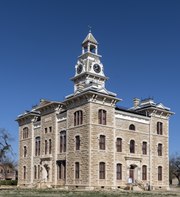- Shackelford County Courthouse (1883–1884); Recorded Texas Historic Landmark #4649, 1962; [3] State Antiquities Landmark #560, 1981 [4]
- Old Jail Art Center (1877–1878); Recorded Texas Historic Landmark #4650, 1962 [5]
- Hartfield Building (1884–1885); Recorded Texas Historic Landmark #12365, 2000 [6]
Shackelford County Courthouse Historic District | |
 Shackleford County Courthouse | |
| Location | Roughly bounded by S. 1st, S. 4th, S. Jacobs, and S. Pecan Sts., Albany, Texas |
|---|---|
| Coordinates | 32°43′22″N99°17′47″W / 32.72278°N 99.29639°W |
| Area | 17 acres (6.9 ha) |
| Architect | Multiple |
| Architectural style | Late Victorian |
| NRHP reference No. | 76002065 [1] |
| Added to NRHP | July 30, 1976 |
The Shackelford County Courthouse Historic District is a historic district in Albany, Texas. It is roughly bounded by South 1st, South 4th, South Jacobs, and South Pecan Streets, centered on the courthouse square. Added to the National Register of Historic Places in 1976, the district includes the Shackelford County Courthouse and a number of surrounding Victorian buildings dating from the late nineteenth and early twentieth centuries.






